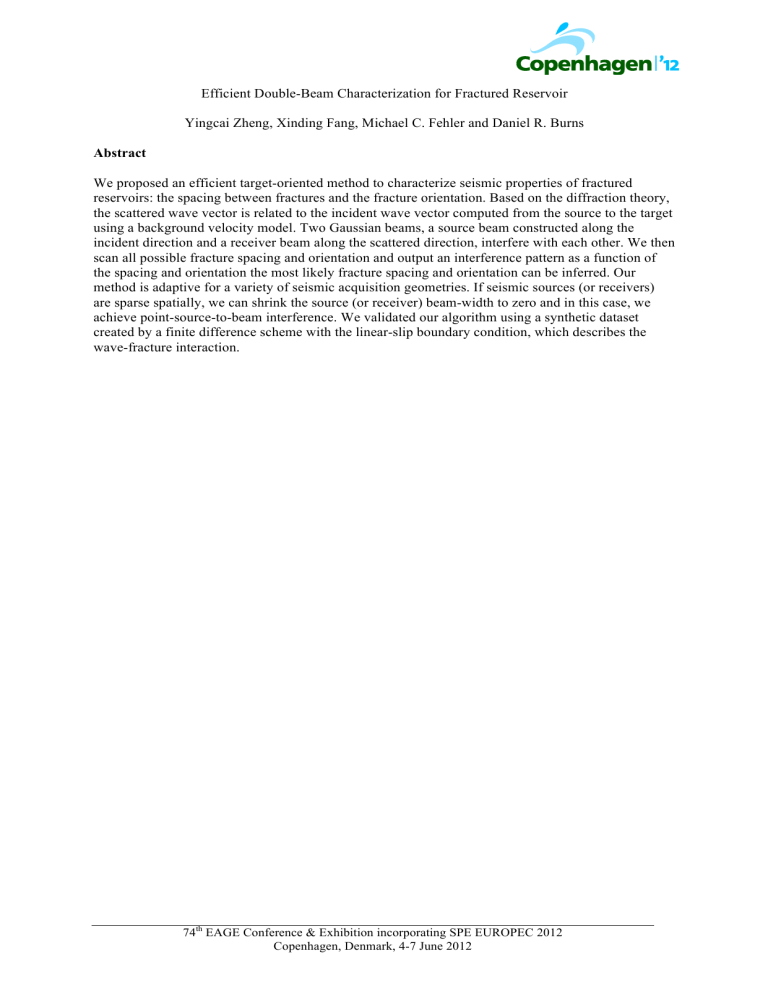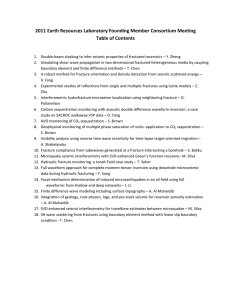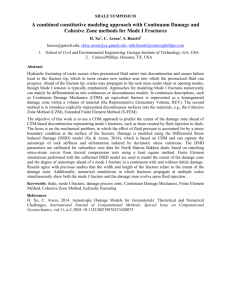Efficient Double-Beam Characterization for Fractured Reservoir

Efficient Double-Beam Characterization for Fractured Reservoir
Yingcai Zheng, Xinding Fang, Michael C. Fehler and Daniel R. Burns
Abstract
We proposed an efficient target-oriented method to characterize seismic properties of fractured reservoirs: the spacing between fractures and the fracture orientation. Based on the diffraction theory, the scattered wave vector is related to the incident wave vector computed from the source to the target using a background velocity model. Two Gaussian beams, a source beam constructed along the incident direction and a receiver beam along the scattered direction, interfere with each other. We then scan all possible fracture spacing and orientation and output an interference pattern as a function of the spacing and orientation the most likely fracture spacing and orientation can be inferred. Our method is adaptive for a variety of seismic acquisition geometries. If seismic sources (or receivers) are sparse spatially, we can shrink the source (or receiver) beam-width to zero and in this case, we achieve point-source-to-beam interference. We validated our algorithm using a synthetic dataset created by a finite difference scheme with the linear-slip boundary condition, which describes the wave-fracture interaction.
74 th
EAGE Conference & Exhibition incorporating SPE EUROPEC 2012
Copenhagen, Denmark, 4-7 June 2012
Introduction
Naturally fractured reservoirs are documented almost everywhere and most worlds’ oil is from fractured reservoirs. Exploring new reservoirs and enhancing the recovery factor for existing reservoirs are the main themes in the current fossil energy landscape. A key element is to obtain an accurate permeability field. Current reservoir simulators have evolved to a state that has already outpaced our ability to supplying a reliable and detailed permeability field. It has been shown that by incorporating a detailed permeability map the predicted well production matches better than using the up-scaled permeability field. For fractured reservoirs, fractures, voids and vugs are ubiquitous features, although small in volume but when interconnected or aligned with each other due to local tectonic stress, they may provide preferable fluid flow paths and therefore they can be more important than the matrix permeability. Reliable assessment of properties of fractures is critical for the oil recovery.
The type of information we are interested in includes fracture orientation, fracture density or spacing and fracture compliance. Widely used seismic methods to characterize fractured reservoirs include shear wave splitting (Vetri et al.
, 2003) and the amplitude-versus-angle-and-azimuths (AVAz) for P waves (Ruger and Tsvankin, 1997). These methods regard the vertically fractured medium as an equivalent anisotropic medium (HTI) with a horizontal symmetry axis. It is essentially a longwavelength approximation, which requires that there are many fractures per wavelength. Tatham et al.
(1992) showed that at least 10 fractures per wavelength is needed for the fractured medium to be viewed as an equivalent anisotropic. However, complex overburden geological structures will make the CDP-based method less accurate and the uneven illumination can also cause bias in the P wave
AVAz analysis. So we need a method, which can account for complex wave phenomenon in the overlying structures. The method should also be able to extract spatially varying fracture information as well as account for the uneven seismic illumination. If the fracture spacing is close to the wavelength, one needs scattering theory to characterize the fractures (Willis et al.
, 2006; Zhang et al.
,
2006; Burns et al.
, 2007; Zheng et al.
, 2011).
Here we develop a double-beam stacking method. The method is a phase-space method and it can provide spatially varying fracture properties for a wide range of scales. Therefore, it is localized in the spatial as well as in the angular domains, necessary for balancing the uneven illumination.
Before we go into the inverse problem of finding fracture orientation and spacing, let us take a look on how fractures scatter seismic waves. For simplicity, we consider plane wave scattering by periodic structures. Scattering by non-periodic structures is a straightforward extension by windowing.
Method and Theory
Here we aim at developing such a new scheme, which we call the double-beam stacking method . The method is a phase-space method and it can provide spatially varying fracture properties for a wide range of scales. Therefore, it is localized in the spatial as well as in the angular domains (Figure 1), necessary for balancing the uneven illumination. Fracture information within the interference zone
(pink area in Figure 1) is extracted. The 5-dimensional seismic data can be represented as p
( x s
, x g
, t
) where symbols x g
and t are source location, receiver location and time, respectively. The doublebeam stacking is an f-k analysis for the localized data, resulting in a 10-dimensional dataset (Figure
1): s
, x where p w
( x s
, x g
, t
)
B
( x 0 s
, x 0 g
, t
0
; k s
, k g
,
!
is the windowed data p w
( x s
, x g
, t
)
= p
( x s
)
=
, x g
#
, t
) p w w s
( x s
, x g
, t
) e i
!
( x s
!
x 0 s
) w g t
(
" i k x s
· g x s
" i k
!
x g
·
0 g
) x g d w t
2 x s d 2 x g dt
( t
!
t
0
)
(1)
(2) where W s
, W g
and W t are windowing functions for sources, receivers and time, respectively. If the source window width W s
is zero, then we have the case of common source gather. Likewise, if
W g
=
0 , we have the common receiver gather. If W s
!
0 and
W g
!
0
, we get beams. t
0
is the center
74 th
EAGE Conference & Exhibition incorporating SPE EUROPEC 2012
Copenhagen, Denmark, 4-7 June 2012
of the time window and it is determined as the traveltime for waves from the source beam center x 0 s to the target then reflected back to the receiver beam center x 0 g
. sour ce
beam receiv er
beam reflector intef erence r egion Reservoir
Figure 1. Interference geometry for double beams. Stars are sources and triangles are receivers. The pink ellipse indicates the interference zone within which the fracture properties can be inferred.
The form of the beams can be taken as Gaussian beams (e.g., Cerveny, 1982). If the beam widths are infinite, then we have plane wave extrapolation such as the double-square-root operator, plane wave migration, offset plane waves etc. The local angle information for waves is essential to perform the illumination correction. The double-beam stacking is a phase-space method and it simultaneously possesses both space and wavenumber properties of the wavefield.
Figure 2. Schematic showing scattering by a set of parallel fracture. Fracture planes are vertical and parallel to the y direction.
It has been recognized that the Born approximation is good for understanding the interference patterns shown. Assume we have a set of vertical fractures that are equally spaced along the x direction and let a plane wave be incident upon the fractures from above (Figure 2). The incident field upon the fractures is exp "# i k s u scatt
(
(
· r
!
r s k g
)
, k
$% s
)
and the scattered field at wavenumber
!
###
V
!
r e i k s
·
( r
" r s
)
+ i k g
·
( ) d 3 r
= !
!
( k g k
" k g s
is
) exp
$% " i k s
· r s
+ i k g
· r g
&' (3) where !
can be thought as the scattering function caused by fractures. Assuming the fracture system is periodic along x and the spacing between two adjacent fractures is a . The scattered wavenumber and the incident wavenumber is related by where e x k g
= k s
+ n
2
!
a e x
, n = 0,
is the unit direction along the x axis. When
± n
1,
=
±
0
2, !
(4)
, it is the specular reflection which corresponds to the common-mid-point (CMP) stacking. Many seismic studies use CMP stacking to infer fracture information. Since the fracture spacing a and its orientation eliminated when e x
are completely n
=
0 , inference of fracture properties using CMP stacking should not be recommended in the context of scattering, i.e., the fracture spacing is comparable to the wavelength. n
= ±
1 corresponds to the forward or backward scattering. For typical seismic exploration applications, n
!
2 is less interesting because the scattered wavenumber is likely to be in the evanescent regime. It has been observed by f-k analysis that the backscattered energy is the strongest
74 th
EAGE Conference & Exhibition incorporating SPE EUROPEC 2012
Copenhagen, Denmark, 4-7 June 2012
(Zhang et al.
, 2006; Grandi, 2008). So in the following numerical example, we only consider the backscattering. By varying the fracture spacing a and its orientation, we effectively stack the seismic data along different moveout curve using equation (1).
Examples
To validate our idea of using our double-beam stacking to infer fracture spacing and orientation, we test our methodology on a synthetic dataset. The 3D model (Figure 3) contains a reflecting interface, which separate the upper and lower media. In the upper medium, V and ! =
2000 kg/m 3 ; and in the lower medium V
P
=
4000 m/s, V
P
/ V
P
S
=
2500 m/s, V
P
/ V
S
=
1.6
=
1.6
and ! =
2300 kg/m 3 . The source time function is a Ricker wavelet with the central frequency 40 Hz. The receivers are in a rectangular domain on the surface and they span from x
=
200 m to x
=
2300 m every 20m and from y
=
200 m to y
=
3500 m every 20m. Six sets of vertical fractures are placed in the lower medium in the depth interval between 1300m to 1380m. The fracture spacing and orientation are different.
Y (m)
X(m)
Figure 3. Fracture model in the numerical example.
To model seismic wave propagation through fractured media, we adopt the linear-slip boundary condition proposed by Schoenberg (1980): the traction is continuous across the fracture surface but the displacement is discontinuous. The normal (or tangential) displacement discontinuity is related to the normal (or tangential) traction by normal (or tangential) compliance. This validity of this boundary condition to model wave-fracture interaction has been supported by a series of laboratory experiments (Pyrak-Nolte and Cook, 1987). In the numerical simulation, we use Coates and
Schoenberg’s (1995) finite-difference effective medium method to simulate fractures with linear-slip boundaries. In this model, the thickness of fractures is assumed to be infinite small and their elastic properties are determined by the fracture compliance. In our simulation, the fracture tangential and normal compliances are equal to 10 -9 m/Pa, which represents gas-filled fracture. As a proof of concept, we pick two targets at depth 1320m. The target A is at ( x, y ) = (1750m, 1700m) and the target B is at
(
1750 m , 750 m
)
. The receiver beam width is 150m and the source beam width is also
150m. The source beam center is at (1200m, 800m). In the double beam stacking, we use frequency of
60 Hz. The fracture spacing is same ( a= 50m) for both localities. The orientation of the fracture symmetry axis at the target A is 20 degrees and at target B it is 0 (or 180) degrees with respect to the x -axis. Our double-beam method is able to recover the fracture spacing and orientation for target A
(Figure 4a) and target B (Figure 4b).
Conclusions
We have introduced a double-beam stacking method, in which the interference of two beams produces a characteristic pattern that depends on fracture spacing and orientation. The method is a phase-space method where point-source field and the plane-wave field are special cases. The method is adaptive for all kinds of acquisition geometry. We calculate the incident wave vector from the source to the target and then compute the backscattered wave vector based on the scattering theory and then stack
74 th
EAGE Conference & Exhibition incorporating SPE EUROPEC 2012
Copenhagen, Denmark, 4-7 June 2012
the energetic backscattered seismic data. It works best when the wavelength and the fracture spacing are comparable. In this case, the common CMP technique cannot yield information on the fracture spacing and orientation. For typical seismic frequency bandwidths (10s Hz) and velocities (1000s of m/s), our method should be able to yield fracture spacing information on the order of 10s of meters for
P-to-P scattering. However, if we use P-to-S scattering, much smaller spacing can be recovered and the stacking technique is same as for the P-P case.
Figure 4. double-beam stacking results at target A (a) and B (b) as a function of fracture spacing
(radius) and orientation. The orientation is for the symmetry axis of the fractures measured CCW with respect to the x-axis. The fracture spacing is measured in meters.
Acknowledgements
This research is sponsored by the Earth Resources Laboratory at MIT.
References
Burns, D. R., M. E. Willis, M. N. Toksoz, and L. Vetri (2007), Fracture properties from seismic scattering, The Leading Edge , 26 (9), 1186-1196.
Cerveny, V., Popov, M.M. & Psencik, I. (1982), Computation of wave fields in inhomogeneous media
-- Gaussian beam approach, Geophys. J. R. astr.
, 70 , 109-128.
Coates, R. T., and M. Schoenberg (1995), Finite-difference modeling of faults and fractures,
Geophysics , 60 (5), 1514-1526.
Grandi, K. S. (2008), Multiscale determination of in situ stress and fracture properties in reservoirs,
Ph.D., 299 pp, Massachusetts Institute of Technology, Boston.
Pyrak-Nolte, L. J., and N. G. W. Cook (1987), Elastic interface waves along a fracture, Geophys. Res.
Lett.
, 14 (11), 1107-1110.
Ruger, A., and I. Tsvankin (1997), Using AVO for fracture detection: Analytic basis and practical solutions, The Leading Edge , 16 (10), 1429-1434.
Schoenberg, M. (1980), Elastic wave behavior across linear slip interfaces, J. Acoust. Soc. Am.
, 68 (5),
1516-1521.
Tatham, R. H., M. D. Matthews, K. K. Sekharan, C. J. Wade, and L. M. Liro (1992), A Physical
Model Study of Shear-Wave Splitting and Fracture Intensity, Geophysics , 57 (4), 647-652.
Vetri, L., E. Loinger, J. Gaiser, A. Grandi, and H. Lynn (2003), 3D/4C Emilio: Azimuth processing and anisotropy analysis in a fractured carbonate reservoir, The Leading Edge , 22 (7), 675-679.
Willis, M. E., D. R. Burns, R. Rao, B. Minsley, M. N. Toksoz, and L. Vetri (2006), Spatial orientation and distribution of reservoir fractures from scattered seismic energy, Geophysics , 71 (5), O43-
O51.
Zhang, Y., X. Campman, S. Grandi, S. Chi, M. E. Willis, M. N. Toksoz, and D. R. Burns (2006), F-K domain characteristics of the seismic response of a set of parallel discrete fractures, SEG
Technical Program Expanded Abstracts , 25 (1), 1727-1731.
Zheng, Y., X. Fang, M. Fehler, and D. Burns (2011), Double-beam stacking to infer seismic properties of fractured reservoirs, SEG Expanded Abstract , 30 (1), 1809-1813.
74 th
EAGE Conference & Exhibition incorporating SPE EUROPEC 2012
Copenhagen, Denmark, 4-7 June 2012
74 th
EAGE Conference & Exhibition incorporating SPE EUROPEC 2012
Copenhagen, Denmark, 4-7 June 2012





